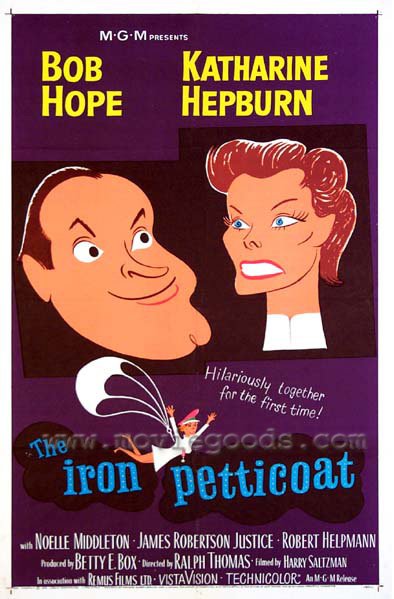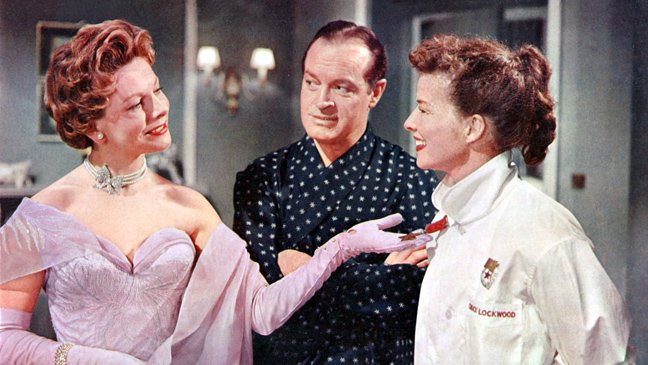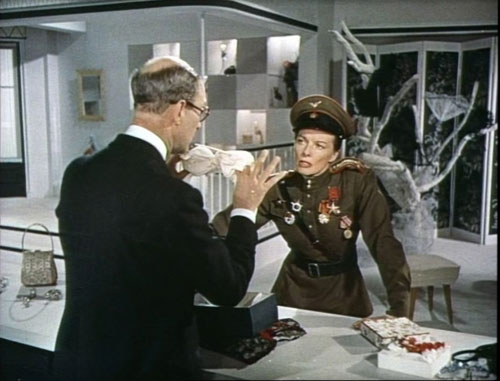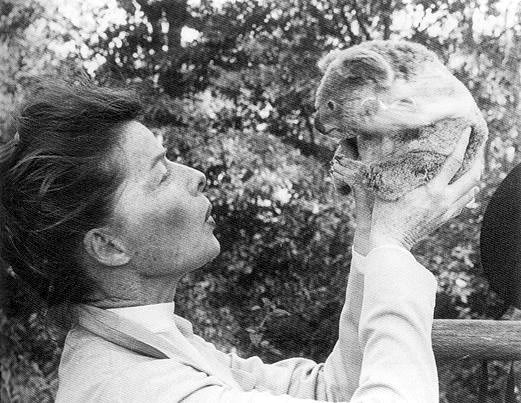Episode 30 of 52: In which you’d think Katharine Hepburn would have learned to stay away from accents by now.
 The 50s were a time of great growth for Kate. The studio system collapsed and stars became more autonomous (Kate had left MGM after Pat & Mike) and Kate used the opportunity to break out of the glamorous-but-dull mold she'd been thrust into. She pursued scripts, directors, and collaborations that electrified her onscreen and off. She toured in Shakespeare, worked with Oscar-nominated directors, and forged a career renaissance even as her contemporaries flailed. Yes, the films she made contained the dreaded "S" word, but if her ladies were single, they were also single-minded and smart. Kate could have been pushed to the side. Instead she found great roles and challenged herself with the opportunities a collapsing system afforded. If her films seem troublesome now, the craftsmanship and artistic growth of this period cannot be denied.
The 50s were a time of great growth for Kate. The studio system collapsed and stars became more autonomous (Kate had left MGM after Pat & Mike) and Kate used the opportunity to break out of the glamorous-but-dull mold she'd been thrust into. She pursued scripts, directors, and collaborations that electrified her onscreen and off. She toured in Shakespeare, worked with Oscar-nominated directors, and forged a career renaissance even as her contemporaries flailed. Yes, the films she made contained the dreaded "S" word, but if her ladies were single, they were also single-minded and smart. Kate could have been pushed to the side. Instead she found great roles and challenged herself with the opportunities a collapsing system afforded. If her films seem troublesome now, the craftsmanship and artistic growth of this period cannot be denied.
And then there's The Iron Petticoat.
Folks, I sprained my shoulder on Friday and ended up in the emergency room. Despite the pain, I would almost rather go through it again than re-watch The Iron Petticoat. It’s that bad. [More...]

The Iron Petticoat is loosely inspired by Ninotchka, the Oscar-nominated comedy from Hollywood’s Golden Year starring Greta Garbo in one of a handful of movies where she didn’t die at the end. The story is basic: Communist woman comes to Western World and falls in love with an American man. Ninotchka was a great success because it worked on the premise of poking fun at its star’s “sour Swede” image. The film was advertised “Garbo laughs!” and gave Garbo the opportunity to blossom from monotone matron to giggly drunk girl. Audiences were charmed, and Garbo showed some seriously underused comedic chops. Take this scene where she gets drunk for the first time:
Do you remember when Kate was being advertised early on as RKO’s new American Garbo? Certainly there was overlap between the two stars’ images: both were considered androgynously beautiful, aggressive, and haughty. This must have occurred to Ben Hecht when he wrote the script for Kate. In The Iron Petticoat, Kate plays Captain Vinka, a woman who defects because she is angry at the Soviet Union for giving her rightfully earned promotion to a man. Her American suitor is played by Bob Hope, who replaced Cary Grant. (When on earth is Bob Hope an acceptable substitute for Cary Grant? Their styles are completely different.) Hope brought in his own team of writers to give the script that (ahem) authentic Hope charm. Kate heard about it and was furious. Their relationship did not improve from there. Unfortunately, that bled into the film:
Kate and Hope have the chemistry of two positively charged magnets: they repel each other when thrust in close proximity, and only touch unwillingly when pushed together by a greater force than themselves. Independently, both are great comedians, but together their timing is way off. Unfortunately, what little timing they had together is further upset by Kate’s terrible Russian accent. It’s been almost two decades since Kate last tried an accent--to equally abysmal results. Fortunately, I think (hope) this is her last attempt.
One final note before we move on: Just as Ninotchka had poked fun at Garbo’s androgyny, Ben Hecht’s script takes aim at Kate’s boyish figure. At one point, Vinka decides to buy a pretty dress to impress the American. Kate’s been wearing pants and a loose jacket the whole film, swaggering like a man, so when she walks into a lingerie shop she and the owner both are startled. The shop owner, on seeing her lack of “assets,” shows her their latest invention, a blow up bra:

She turns it down, but her body does take on an unusually hourglass shape in the next scene. This is the first time Kate’s androgyny has been lampooned as a negative. The mid 1950’s were the time of Monroe, Taylor, and Mansfield. Postwar America had a thing for what Marjorie Rosen dubbed “mammary madness.” Kate’s skinnier frame was decidedly out of fashion. Fortunately, her acting talent was only getting stronger.
We got through The Iron Petticoat! To celebrate, please enjoy this picture of Kate with a Koala, taken during her Australian tour of Measure for Measure.


Previous Week: Summertime (1955) - In which David Lean's beautiful romantic classic gives Katharine Hepburn an eye infection and me a headache
Next Week: The Rainmaker (1956) - In which Katharine Hepburn lets her hair down and rolls in the hay with Burt Lancaster
Tuesday 8/12: Hit Me With Your Best Shot crossover -Suddenly, Last Summer